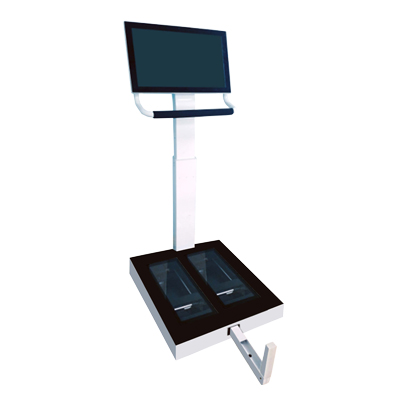Plantar scanners are playing an increasingly important role in modern health management, especially in the fields of foot function assessment, sports rehabilitation, and customized insole design.
Among these, laser-based plantar scanners are widely used due to their high precision and non-contact measurement advantages.
So, what specific conditions of the foot can be detected using laser-based plantar scanning?
Laser foot scanners operate on the principle of laser triangulation or structured light scanning. The device projects one or multiple laser lines onto the surface of the foot. As these lasers deform along the foot’s contours, high-resolution cameras capture the bent shape of the laser lines from specific angles. Using computer algorithms to analyze the displacement and deformation of the laser lines, the system reconstructs a precise 3D model of the foot, enabling comprehensive analysis of its morphology and structural characteristics.

First, laser scanning can clearly identify arch type. Through 3D modeling, the system can accurately determine whether an individual has a normal arch, flat feet (pes planus), or high arches (pes cavus). For example, individuals with flat feet exhibit a collapsed arch, resulting in a significantly increased contact area between the sole and the scanning platform—particularly on the medial midfoot, which nearly fully touches the ground. In contrast, high arches are characterized by a raised midfoot, reduced contact area, and concentrated pressure on the forefoot and heel. These morphological differences are clearly visible in the 3D images generated by laser scanning, providing a solid basis for subsequent corrective interventions.
Second, laser scanning enables precise measurement of foot dimensions and contours. Traditional measuring methods using rulers are prone to error, whereas laser scanning can capture dozens of parameters—such as foot length, width, girth, and arch height—within seconds, with millimeter-level accuracy. This is crucial for customizing orthotic insoles, athletic shoes, or post-surgical rehabilitation aids, ensuring a perfect fit that enhances comfort and functional performance.
Additionally, laser scanning can assist in assessing gait and foot symmetry. While primarily used for static scanning, some advanced systems support dynamic scanning, continuously capturing changes in foot shape during walking. By comparing the 3D models of the left and right feet, doctors or therapists can identify developmental asymmetries, inward or outward turning of the feet, or other imbalances. For instance, postural abnormalities such as tibial torsion or calcaneal valgus may appear in laser images as tilted heels or shifted arches, helping to detect potential biomechanical issues at an early stage.
It’s worth noting that laser scanning offers the advantages of being non-contact, fast, and painless, making it especially suitable for children, elderly individuals, and those sensitive to physical contact. The entire process requires no forceful stepping or prolonged standing—subjects simply place their feet on the scanning area, and data collection is completed within seconds, greatly improving convenience and user experience.
It should be noted that while laser scanning excels at capturing morphological structure, understanding plantar pressure distribution or dynamic loading conditions requires complementary technologies such as pressure-sensing platforms. Nevertheless, from a purely morphological perspective, laser scanning already provides extremely rich information and has become an indispensable tool in foot health assessment.
In conclusion, laser-based plantar scanners not only accurately present the 3D shape of the foot but also effectively identify arch types, measure critical dimensions, and evaluate symmetry and postural abnormalities. They provide scientific support for early screening of foot disorders, personalized orthotic interventions, and optimization of athletic performance.
With continuous technological advancements, laser scanning is turning the concept of “custom-fit” into reality, enabling truly refined management of foot health.
